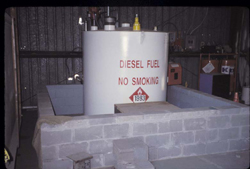New York Sea Grant's
Marina Pollution Prevention Web Site
Section 4: Fueling
- Fuel
Storage
Potential Environmental Impacts
 Accidental
fuel spills can be damaging to the marina environment. According
to the EPA, the hydrocarbon compounds in oil and gasoline can
be toxic to marine life, upset fish reproduction and interfere
with growth and reproduction of bottom dwelling organisms even
in small concentrations.
Accidental
fuel spills can be damaging to the marina environment. According
to the EPA, the hydrocarbon compounds in oil and gasoline can
be toxic to marine life, upset fish reproduction and interfere
with growth and reproduction of bottom dwelling organisms even
in small concentrations.
Best Management
Practices
Because petroleum
spills can have significant environmental and safety impacts,
storage facilities are closely regulated. Make sure your facility
complies with the state and federal regulatory requirements regarding
fuel storage listed below.
Keep all information
about registered underground storage tanks, subsequent updates
from your state environmental agency, and maintenance records
in file in a central location.
Regularly
inspect aboveground fuel storage tanks and associated piping for
leaks.
If possible
and appropriate, cover above ground tank with a roof to prevent
rainwater from filling the containment area.
Regulatory
Issues
If your facility
stores 10,000 pounds or more of gasoline (about 1626 gallons),
diesel fuel, and/or fuel oil (about 1390 gallons), either above-
or underground for dispensing or for on-site use, you must report
storage of that substance under the Emergency Planning and Community
Right-to-Know Act of 1986 (EPCRA) [40 CFR 355, click
here]. For more information on EPCRA requirements,
click
here.
Both above
and underground storage tanks and their piping systems are subject
to the National Fire Protection Association's (NFPA) Automotive
and Marine Service Station Code (NFPA 30A). (To view a copy
of this section of the code on line at the NFPA Web site, click
here.) These requirements are adopted locally.
Check with your municipal fire marshal for local requirements,
or contact the State Fire Marshall's Office (In New York call
(518) 474-6746 or e-mail at fire@dos.state.ny.us).
Underground
Petroleum Storage: Tanks with ten percent or more of total volume
below grade (including the volume of connected underground pipes)
are considered Underground Storage Tanks (USTs) and must meet
certain requirements, which have been in effect since1985. For
more information on the federal UST program, click
here. Specific program requirements can vary state
by state and by regions within a state. The general requirements
are that:
1) the tank
and piping be constructed of noncorrosive materials or externally
coated cathodically protected steel and installed
according to
manufacturer's specifications
2) the facility has an approved method of leak detection which
includes the maintenance of all activity records for 5 years
3) fill-pipes on tanks have means to collect spills from delivery
hoses
4) the tanks have overfill protection, such as automatic shutoff
devices which activate at 90% UST capacity and restrict flow during
deliveries
5) the tank be registered with the state environmental agency
and the local fire marshal and
6) if a facility has a total underground buried storage capacity
of more than 42,000 gallons of petroleum product, it may require
a Spill, Prevention, Control, and Countermeasure (SPCC) Plan [40
CFR 112, click
here]. (For more information on the federal
program for marinas, click
here). For a sample SPCC plan, click
here.
There are
additional requirements for facility owners or operators when
they are closing USTs through removal or in-place abandonment.
Aboveground
Petroleum Storage: If your facility stores a certain amount of
gas or oil in aboveground tanks (total aggregate volume greater
than 1,320 gallons) it may require an SPCC Plan [40 CFR 112,
click
here] which outlines a facility-wide plan to prevent
spills and contingency plans in case of spills. (For more information
on the federal program for marinas, click
here). For a sample SPCC plan, click
here. The aboveground storage tank should be located
within a dike or over an impervious storage area with containment
volumes equal to 110% of the capacity of the storage tank.
Gasoline Storage:
Air emissions from refueling operations are addressed in U.S.
EPA's AP-42 Section 5.2.2.2, click
here and in New York in 6 NYCRR Part 230, click
here. In New York, Part 230 does not apply as long
as no vehicles are refueled from the marina gasoline pumps and
there is no drop tube in the storage tank. In addition, Stage
1 and Stage II Vapor Recovery are not required if no vehicles
are refueled at the facility. For information on New York's air
regulations related to marinas, click on the New York Regulatory
Compliance Button at the bottom of this page.
Any petroleum
product that is discharged to the waters of the state must be
reported to the state (In New York call the NYSDEC Oil Spill Hotline
at (800) 457 7362) For more information on spill response requirements,
click
here.
If any petroleum
product discharged into navigable waters causes a visible sheen,
it may also be necessary to report the discharge to the National
Response Center at (800) 424-8802.
A hazardous
waste determination must be conducted on any materials used to
clean a spill to determine whether or not disposal of the materials
is subject to hazardous waste regulations [40 CFR 262.11, click
here]. For more information on New York hazardous
waste testing requirements, click
here. If they are hazardous, they must be managed
as a hazardous waste. For more information on New York's Hazardous
Waste Regulations and storage requirements, click
here.
If there is
a stormwater discharge from your facility you may have to register
for a General Permit for the Discharge of Storm Water Associated
with Industrial Activity ("Storm Water General Permit").
For more information on storm water permitting in New York,
click
here.

